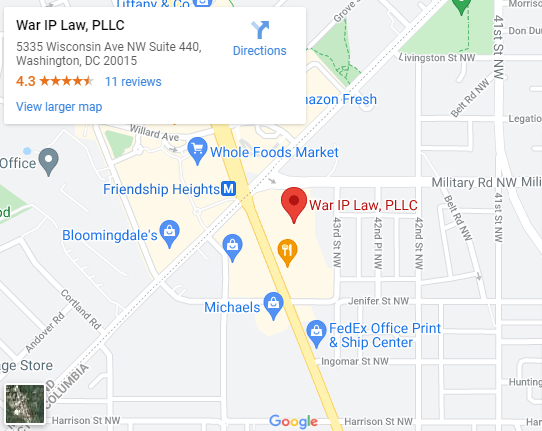If the United States Patent and Trademark Office (USPTO) believes an applied for mark is registerable and it was not in use at the time the trademark application was filed, the USPTO issues the trademark applicant a Notice of Allowance (NOA) during the trademark registration process. However, the NOA only indicates preliminary approval; proof of using the mark in commerce will still be necessary to have the registration be issued. To prevent delays in the registration process and potentially having their trademark registration listed as “abandoned,” applicants may wish to familiarize themselves with the USPTO requirements for demonstrating trademark use in commerce. Explore what occurs if an applicant does not use the trademark in commerce on all goods and/or services listed in the Notice of Allowance and learn more about how a Washington, D.C. intellectual property (IP) lawyer may be able to assist businesses and individuals with their trademark concerns by calling War IP Law PLLC at (202) 800-3754 to schedule your consultation today.
Trademarks Explained
The term trademark may refer to any identifying sign that determines the source of a particular good or service. Marks are often highly valuable business assets that can help establish a company’s reputation and trustworthiness. Provided the mark is unique and non-descriptive, any of the following may be registered as a mark:
- Words
- Logos
- Shapes and patterns
- Single colors or a combination of them
- Sounds
- Movement
- Multimedia
- Positions
- Holograms
Why Register Trademarks?
Registering trademarks can carry numerous benefits. Some of these include:
- Registered marks, and pending registrations, show up in USPTO database searches, serving as notice to any party looking for similar marks.
- Registrations create a legal presumption of ownership and exclusive usage rights, making it far easier to bring infringement claims.
- Registered marks gain IP protection on a federal level, whereas unregistered marks only obtain protection in the geographic areas they were used in.
- Trademark owners can use the federal registration symbol ® alongside their registered trademarks to signal the mark’s registered status, which can deter potential infringers.
- Trademark owners who have successfully registered their marks with the USPTO may also record those registrations with United States Customs and Border Protection, enabling the federal government to identify infringing goods at the border and bar them from entering the country.
Notice of Allowance Defined
The USPTO explains that the office only issues NOAs for applications filed under Section 1(b) of the Trademark Act, based on the trademark registration applicant’s intent to use the trademark in interstate commerce. Typically issued roughly eight weeks following the mark’s publication date in the Trademark Official Gazette, the USPTO grants NOAs if the mark meets the registration requirements and no party has filed either an opposition to its registration or a request for an extension to the opposition period. Importantly, at this point the mark has not yet achieved registration; to progress to the next stage of the registration process, the applicant must do one of the following no later than six months after receiving the NOA:
- Use the trademark in a commercial setting, providing specimens to demonstrate this, and file an SOU.
- Request an extension of six months to the time limit for submitting the SOU.
Learn more about what happens if the applicant for trademark registration is not using the trademark in commerce on all of the listed goods/services in the Notice of Allowance by getting in touch with an intellectual property lawyer from War IP Law PLLC.
What Does Using the Trademark in Commerce Mean?
The USPTO operates under the auspices of the United States Department of Commerce. For the purposes of USPTO trademark registration, therefore, “use in commerce” refers specifically to the trademark’s use in interstate commerce, as commerce conducted within the borders of a single state will typically fall under the jurisdiction of the governing authorities pertaining to that state. The “use” portion of the terminology signifies genuinely utilizing the trademark in the normal course of business. Crucially, the party trying to prove commercial use of the mark cannot use the mark in a commercial setting solely to gain the rights to it.
NOAs and Using the Mark in Commerce
Trademark applicants will face a distinct set of conditions depending on whether they are using or not using the trademark in a commercial setting on all listed goods/services in the NOA. The requirements in each case are as follows:
- Using on all listed goods/services: Applicants must file an SOU and specimens, alongside the stipulated fees, no later than six months after the date of issue of the NOA to prevent abandonment. They may not withdraw the submitted SOU, but, in some circumstances, they can file an extension request to gain additional time to prove a genuine intention to use the mark in connection with all listed goods and services in the NOA if required.
- Not using on all listed goods/services: The applicant has to submit a form to request an extension and pay the necessary fees to prevent abandonment. They must continue this process every six months (up to a maximum of five times) from the date of issue of the NOA until filing the SOU.
- Dividing the application: If an applicant is using the mark with some of the goods and/or services, but not all of the goods and/or services, they may also be able to split the trademark application into two different applications and file a SOU for the goods and/or services that the mark is being used with and request an extension of time for the goods and/or services the mark is not yet being used with.
Does a Trademark Have To Be Used in Commerce?
Trademark owners can submit applications for federal trademark registration on either of filing bases: on an intent to use basis or on a use in commerce basis. Both filing bases ultimately require registrants to demonstrate commercial use of the mark, but the stage at which the proof is required will differ, depending on whether the filing basis is use in commerce vs. intent to use. Below is an explanation of these filing types:
- Intent to use: Applicants filing under this basis have yet to begin using the mark in a commercial context but possess a genuine intention to do so and expect to be actively using the mark in interstate commerce in the imminent future –– within three years from the date of the NOA, according to the USPTO’s resources on application filing basis.
- Use in commerce: Applicants who are currently using their mark to sell or transport goods to other states or using it in connection with services provided to customers in alternative states file under this basis. Registering marks via this filing requires applicants to submit evidence of commercial use by providing specimens of the mark in use, alongside the dates of initial use and first commercial use. The types of materials accepted as specimens vary depending on whether the mark is being applied to goods or services, but often include product packaging or service brochures that show how the mark is being used.
Does a US Trademark Require Use in Commerce To Maintain the Mark?
Trademark registrants must use their mark in commerce to maintain registration, according to guidance provided by the USPTO. Furthermore, they have to regularly file renewal documentation to demonstrate this continued use. Failure to submit the required paperwork can result in the cancellation or expiry of the trademark registration.
Schedule a Consultation With a Trademark Attorney in Washington, D.C.
Per the USPTO, applicants who are not commercially using the trademark on all listed services or goods in the NoA must submit a form to request an extension and pay the necessary fees for doing so to avoid having their application for trademark registration classed as abandoned When needed, an extension can give the applicant time to collate the necessary specimens and documentation to progress their trademark application and confirm registration. Learn more about what takes place when an applicant does not use their trademark in commerce on all of the goods/services listed in the NoA and see how a trademark attorney with War IP Law PLLC can aid clients with their trademark-related issues by calling (202) 800-3754.






